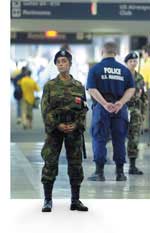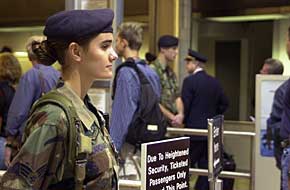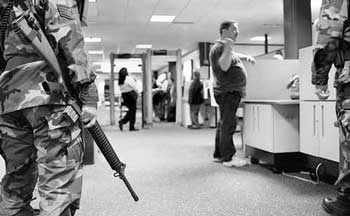 In
the most aggressive -- and, some say, invasive -- step
yet to protect air travelers, the federal government and
the airlines will phase in a computer system next year
to measure the risk posed by every passenger on every
flight in the United States.
In
the most aggressive -- and, some say, invasive -- step
yet to protect air travelers, the federal government and
the airlines will phase in a computer system next year
to measure the risk posed by every passenger on every
flight in the United States.
The new Transportation Security
Administration system seeks to probe deeper into each
passenger's identity than is currently possible,
comparing personal information against criminal records
and intelligence information. Passengers will be
assigned a color code -- green, yellow or red -- based
in part on their city of departure, destination,
traveling companions and date of ticket purchase.
Most people will be coded green and
sail through. But up to 8 percent of passengers who
board the nation's 26,000 daily flights will be coded
"yellow" and will undergo additional screening at the
checkpoint, according to people familiar with the
program. An estimated 1 to 2 percent will be labeled
"red" and will be prohibited from boarding. These
passengers also will face police questioning and may be
arrested.
 The
system "will provide protections for the flying public,"
said TSA spokesman Brian Turmail. "Not only should we
keep passengers from sitting next to a terrorist, we
should keep them from sitting next to wanted ax
murderers."
The
system "will provide protections for the flying public,"
said TSA spokesman Brian Turmail. "Not only should we
keep passengers from sitting next to a terrorist, we
should keep them from sitting next to wanted ax
murderers."
The new system, called Computer
Assisted Passenger Pre-screening System II (CAPPS II),
has sparked so much controversy among both liberal and
conservative groups that the TSA has struggled to get it
going. Delta Air Lines backed out of a testing program
with the agency earlier this year, and now the TSA will
not reveal which airlines will participate when it tests
a prototype early next year. If all goes as planned, the
TSA will begin the new computer screening of some
passengers as early as next summer and eventually it
will be used for all domestic travelers.
"This system is going to be replete
with errors," said Barry Steinhardt, director of the
American Civil Liberties Union's technology and liberty
program. "You could be falsely arrested. You could be
delayed. You could lose your ability to travel."
In the two years since the Sept. 11,
2001, terrorist hijackings, air security has taken a
high priority, and the government has spent $9 billion
on improvements. Thousands of explosives-detection
machines now scan checked luggage at airports across the
nation. A new force of federal airport screeners staffs
checkpoints, though next year some airports may revert
to private screeners. Cockpit doors have been
reinforced, and hundreds of airline pilots now carry
guns. In addition, the force of undercover air marshals
has been expanded, and as many as 5,000 federal
immigration and customs agents will be trained to
bolster the force on a temporary basis when the
government perceives a heightened threat.
 Still,
many holes in security persist. Airports and aircraft
still appear easy to penetrate, illustrated last month
by an accidental landing of several boaters on the
airfield at John F. Kennedy International Airport. Air
cargo remains vulnerable, as virtually none of the items
stowed alongside luggage in the aircraft hold are
screened for explosives. Government officials continue
to assess how best to respond to the possibility of a
shoulder-fired missile attack at a commercial airliner,
which they maintain is a serious threat.
Still,
many holes in security persist. Airports and aircraft
still appear easy to penetrate, illustrated last month
by an accidental landing of several boaters on the
airfield at John F. Kennedy International Airport. Air
cargo remains vulnerable, as virtually none of the items
stowed alongside luggage in the aircraft hold are
screened for explosives. Government officials continue
to assess how best to respond to the possibility of a
shoulder-fired missile attack at a commercial airliner,
which they maintain is a serious threat.
In the coming months, major airports
in Los Angeles, Seattle, Denver and Dallas will embark
on extensive construction projects to build
explosives-detection machines into conveyor-belt systems
that sort checked luggage being loaded onto planes.
(Other airports, including Washington's, are waiting in
line for hundreds of millions of dollars in government
funding.)
Clearly, the TSA says, the job of
protecting the nation's skies is not done.
"Given the dynamic nature of the
threat we deal with, it would be impossible to predict
when the work would be finished" on air security, said
TSA spokesman Robert Johnson. "We don't think it will
ever end."
The government says the most
significant change in security is still to come in the
form of CAPPS II. The current computer screener program
was developed by U.S. airlines in the mid-1990s in
response to government and public pressure to improve
air security after terrorists blew up Pan Am Flight 103
over Lockerbie, Scotland.
The existing system identifies certain
passengers as risky based on a set of assumptions about
how terrorists travel. For instance, passengers are
flagged for additional screening if they bought a
one-way airline ticket, or if they paid with cash
instead of a credit card. Passengers who present a
threat under these and other criteria are issued
boarding passes that bear a coding of "SSS" or "***."
But the TSA, recognizing that the
system is outdated and easy to fool, wants to replace it
and put the government in the role now played by the
airlines in making security assessments.
Under the new program, the airline
will send information about everyone who books a flight
to the TSA, including full name, home address, home
telephone number, date of birth and travel itinerary. If
the computer system identifies a threat, the TSA will
notify federal or local law enforcement authorities. The
agency has not indicated the number or type of personnel
needed to oversee the program.
The TSA will check each passenger in
two steps. The first will match the passenger's name and
information against databases of private companies that
collect information on people for commercial reasons,
such as their shopping habits. This process will
generate a numerical score that will indicate the
likelihood that the passenger is who he says he is.
Passengers will not be informed of their color code or
their numerical score. The second step matches passenger
information against government intelligence combined
with local and state outstanding warrants for violent
felonies.
Airlines like the system because they
think it will reduce time passengers spend at security
checkpoints and lower the likelihood that they will be
delayed for their flights. The TSA said the program is
expected to flag fewer people than the current computer
screening system. The agency intends to test the program
in several phases to ensure that it works as promised.
"If it delivers the way it's
envisioned, it's going to be a significant, positive
change," the TSA's Johnson said. "It's going to be a lot
fewer people [flagged], but we think it will be the
right people."
David A. Keene, chairman of the
American Conservative Union, worries that the computer
screening program will go beyond its original goals.
"This system is not designed just to get potential
terrorists," Keene said. "It's a law enforcement tool.
The wider the net you cast, the more people you bring
in."
As the government takes a new, large
role in one aspect of screening, it is rolling back its
presence in another. By late 2004, some airports are
expected to replace the federal screening force with
private screeners. A security law passed after the
terrorist attacks allows airports to "opt out" of the
government's federal screening workforce in November
2004. Many airports, frustrated with the staffing cuts
and the inability to control the number of screeners at
each station, believe they might have more control over
the operations if a private company were in charge.
"I've been in various meetings with
many airport managers who are saying, 'We don't want as
much government control around,' " said James McNeil,
chief executive of McNeil Technologies Inc., which
provides security screeners at the airport in Rochester,
N.Y., one of five test airports that employ private
screeners. McNeil said he has talked to 20 to 30
airports that are interested in his services. A large
association of the nation's airports estimates that many
small airports will opt out of government screeners next
year because their limited flight schedules require that
screeners work flexible hours. The government will still
have a role in security because the private screening
companies will operate under contracts managed by the
TSA.
If many airports, particularly large
hubs that handle a major portion of the nation's 30,000
daily flights, choose to revert to the private screening
force, some aviation industry leaders have wondered what
that will mean for the TSA.
The agency, created just months after
the terrorist attacks, has already seen some of its
authority stripped. The Federal Air Marshal Service has
moved to a law enforcement division within the
Department of Homeland Security, as has the agency's
explosives unit. Some of its security directors claim
they are still out of the loop on some of the agency's
latest intelligence on air security.
Johnson, the TSA spokesman, hinted
that the agency's future is unclear.
"We've got a department-level
organization now created for that sole purpose [of
fighting terrorism] and it only makes sense, where
necessary, to economize and coordinate," Johnson said.
"There will always be a need to provide the best
aviation security possible at airports. Whether it's
under one flag or another, it really makes no
difference."